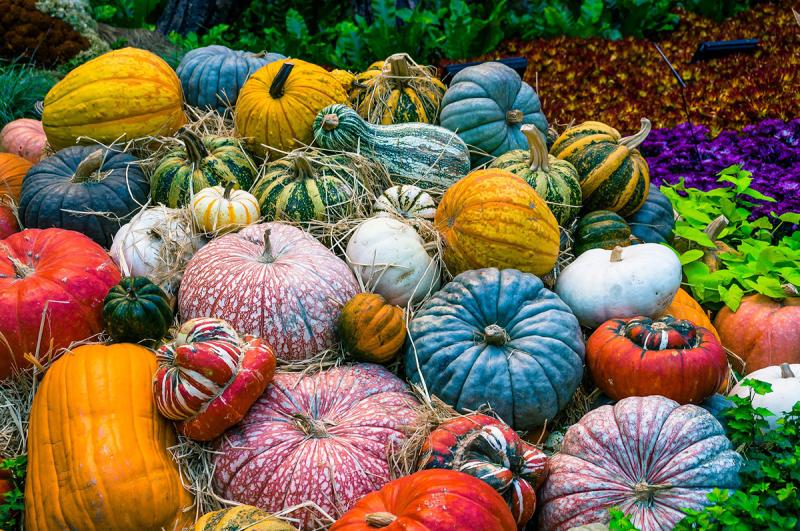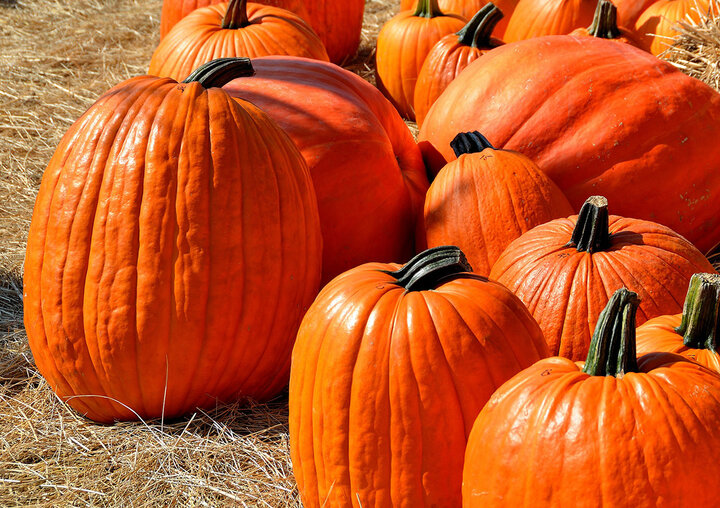Sarah Browning, Nebraska Extension Educator

Colorful pumpkins and gourds are popular fall decorations this year. Image by Pixabay.
Colorful pumpkins and gourds are popular fall decorations, and their appearing for sale in many locations now. But no matter if you're growing or purchasing pumpkins or gourds for display, decoration, cooking or storage, choosing the best specimens and storing them properly is key.
Select Healthy, Mature Pumpkins & Gourds
It's important for good storage and longer-life in display specimens to harvest pumpkins and gourds that are fully mature, but before a hard freeze. Light frost, approximately 32-28 F degrees, is OK. It will cause the vines to dieback but not damage the fruits. Hard frost, in the mid to low 20s, will damage pumpkins reducing their storage potential and cause gourds to rot before they can be dried.

Pumpkins should have hard shells with a shiny surface that can't be punctured by a fingernail. Also check for firm, bright green stems. Weak stems often indicate a plant that had a foliar disease, which could make the pumpkin more prone to rotting. Stems cut too close to the pumpkin will also cause it to decay quicker.
Mature gourds are a dull color and have stems or vines that are totally dry. Do not test gourds with a fingernail, as this may puncture or dent the skin and reduce the quality of the gourd.
Even if you didn't grow it yourself, you can use these techniques to choose good specimens at the farmers market or roadside stand.
Once the shell and stem have passed quality tests, pumpkin and gourd choices are purely personal. Misshapen specimens are as safe to eat or handle as uniformly-shaped ones. Blue pumpkins, white pumpkins, small pie pumpkins and other less common varieties are becoming increasingly popular.
If you plan to use the pumpkin for cooking, it's best to select a pie pumpkin or sweet pumpkin. They are usually smaller than jack-o-lantern types with sweeter, less watery flesh. But if you really want to use a jack-o-lantern type pumpkin for cooking you certainly can and should have fairly good results. Just don't plan to cook with a pumpkin after it has been carved and displayed - these should be discarded.
Cleaning and Storage
After choosing pumpkins and gourds, there are many options on how to use them. Besides using them for cooking or other purposes, pumpkins and gourds may be carved, dried, polished or decorated. However, they must be stored properly so they don't rot.
Washing and disinfecting pumpkins and gourds is not required, but it often helps them keep longer. Wipe down or wash the exterior with a dilute bleach solution, about 1 tablespoon of bleach per gallon of water. This removes surface bacteria and fungal spores.

Pumpkins can easily be stored for 2-3 months, so its no problem if you harvest in early October. If they haven't gotten frosted and are cured properly, pumpkins destined for Halloween carving will store just fine.
Polishing decorative pumpkins is another popular preparation for display. Acrylic liquid floor wax and polyurethane spray work well and make the pumpkins shiny. Be sure not to eat pumpkins that have been treated in this way.
Drying Gourds
To dry gourds, leave them in an area that has good ventilation and is warm and dry, such as a garage or attic. Gourds should not touch each other while drying. They will shrink as they dry. Different sized gourds require different amounts of time to dry, but expect to wait several months. One way to tell if a gourd is dry is by shaking it. If the seeds can be heard rattling inside, it likely has dried.
A layer of mold may develop on the gourd's skin during the drying process. Leave the mold until the gourd is completely dry; it usually will wash off then or can be rubbed off with a rough cloth or fine sandpaper. Dried gourds, if kept dry, will last indefinitely.
Images from Pixabay.